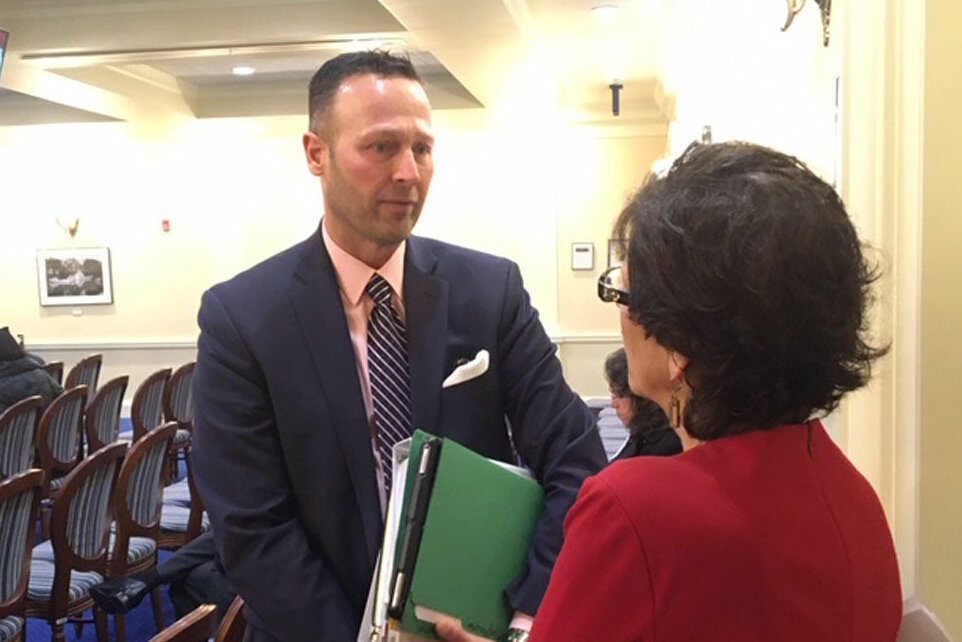This article was republished with permission from WTOP’s news partners at Maryland Matters. Sign up for Maryland Matters’ free email subscription today.

This content was republished with permission from WTOP’s news partners at Maryland Matters. Sign up for Maryland Matters’ free email subscription today.
As Maryland begins the process of awarding billions of dollars in Washington, D.C.-area road-widening contracts, the state’s acting Transportation Secretary said his agency will work to find firms that can minimize the loss of private homes.
State Highway Administrator Greg Slater, who has been tapped by Gov. Lawrence J. Hogan Jr. (R) to lead the Department of Transportation, also told a House panel Tuesday that the firm that wins the right to build a new American Legion Bridge and to widen two Montgomery County highways will be the one that figures out how to keep traffic flowing while constructing the new Potomac River crossing.
“Those are maintenance-of-traffic details that we have to work out with whoever our selected vendor is,” Slater told the House Environment & Transportation Committee. “We just can’t disrupt that travel too much during construction.”
The same preference-setting will be used on the road-widening components of the project — in which the state builds Express Toll Lanes on the western-most portion of the Capital Beltway and the southern-most leg of Interstate 270.
Under an early design, the state was going to need to seize 34 homes or businesses through eminent domain.
Slater wants that number lowered as much as possible.
“We’ve laid the solicitation out so that we’re going to be asking the private sector vendors to come in, take our concept and then further minimize [the need for private property],” Slater told the committee. “That will be part of our selection criteria.”
In the wake of a controversy stirred by his predecessor, Pete K. Rahn, Slater pledged that “we will not acquire any properties until all approvals are in place.”
Responding to a question from Del. Marc Korman (D-Montgomery), Slater said he hopes to be able to share the state’s “traffic and revenue model” with county governments and the Maryland National Capital Park and Planning Commission.
Slater stopped short of a blanket commitment, because some of the data the Maryland Department of Transportation is using is proprietary. But he said he is working with agency lawyers to be as open as possible.
Local planners have long sought “origin and destination data” — where commuters start and end their travels — so that they can conduct their own analysis of the state’s controversial $11 billion project.
He also said that hearings on the tolls commuters will face will be held in counties where the projects are to occur.
Korman, a member of the Appropriations Committee, was allowed to sit in on the E&T briefing — and he tried to get Slater to commit to key components of the deal that Comptroller Peter V.R. Franchot (D) struck with Hogan, with whom Franchot serves on the three-member Board of Public Works.
Among them:
- Buses and other mass transit vehicles will be allowed to use new Express Toll Lanes free of charge;
- Counties impacted by the state’s road-widening plan will get a share of toll revenues as soon as the lanes open, for use in improving local transit;
- MDOT will enter into a “community benefits agreement” with affected counties;
- No contract will be submitted to the BPW until the federally-mandated environmental review is complete;
- The new American Legion Bridge will have a barrier-separated bike/pedestrian lane;
- A loan from the Maryland Transportation Authority to the winning bidder will be repaid in full and there will be no additional taxpayer expenses;
Korman asked if MDOT has “a commitment to use all-union labor on the project.” Slater said no.
Franchot has boasted that his deal with Hogan stipulates “union jobs at union wages.” A Franchot aide said in an interview that labor and other issues will be included in the community benefits agreement.
Slater, yet to be confirmed by the Senate, also was peppered with questions about other transportation needs, including the desire for transit that links Southern Maryland with the D.C.-area’s Metro system; improvements to the Beltway interchange at Arena Drive, near the new Prince George’s County hospital; ongoing changes in the way the state collects tolls at the Chesapeake Bay Bridge; and the expansion of MARC train service.
Despite a recent Trump administration ruling on greenhouse gases, Slater pledged the state would continue to use its own benchmarks for measuring the impact of vehicle use on the state’s air quality.
Monorail briefing
The committee also heard from Robert Eisinger, a Montgomery County businessman who has spent years — and $400,000 of his own fortune — studying the potential use of monorail to speed commuters between Frederick County and the Shady Grove Metro station in Montgomery County.
Eisinger told the committee that other nations have been using monorail successfully for decades because it needs very little land, costs less than heavier commuter rail systems, and is more environmentally friendly.
Eisinger, who paid for a first study himself, wants the state to put up $200,000 for a more detailed review.
Although committee Chairman Kumar P. Barve (D-Montgomery) didn’t explicitly endorse the concept, he told his colleagues, “I want this committee to think about outside-the-box technologies.”







